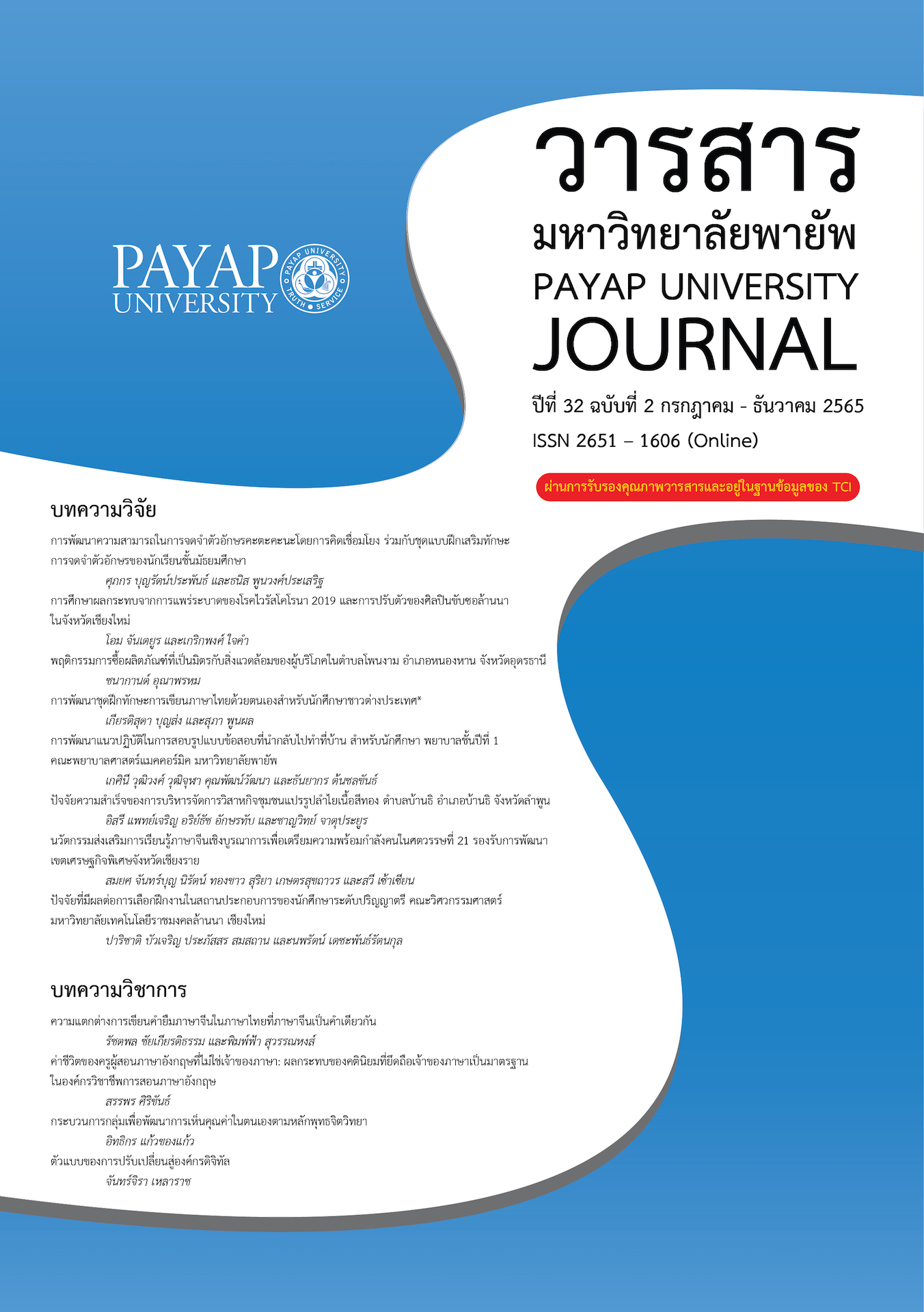การพัฒนาความสามารถในการจดจำตัวอักษรคะตะคะนะโดยการคิดเชื่อมโยง ร่วมกับชุดแบบฝึกเสริมทักษะการจดจำตัวอักษรของนักเรียนชั้นมัธยมศึกษา
Main Article Content
บทคัดย่อ
การวิจัยครั้งนี้มีวัตถุประสงค์ 1) เพื่อพัฒนาความสามารถในการจดจำตัวอักษรคะตะคะนะโดยการคิดเชื่อมโยงร่วมกับชุดแบบฝึกเสริมทักษะการจดจำตัวอักษร โดยตั้งเป้าหมายให้ผู้เรียนมีคะแนนเฉลี่ยจากแบบทดสอบร้อยละ 70 ขึ้นไป 2) เพื่อศึกษาความคิดเห็นของผู้เรียนที่มีต่อการจัดกิจกรรม การเรียนรู้ กลุ่มเป้าหมายในการวิจัยคือ นักเรียนชั้นมัธยมศึกษาของโรงเรียนศรีกระนวนวิทยาคม จังหวัดขอนแก่น จำนวน 20 คน ซึ่งได้มาโดยการเลือกตัวอย่างแบบเจาะจง ผู้วิจัยใช้รูปแบบการวิจัย เชิงปฏิบัติการจำนวน 3 วงจร โดยมีเครื่องมือที่ใช้ในการวิจัยแบ่งออกเป็น 3 ประเภท คือ 1) เครื่องมือที่ใช้ในการปฏิบัติการ ได้แก่ แผนการจัดการเรียนรู้ และชุดแบบฝึกเสริมทักษะการจดจำตัวอักษร 2) เครื่องมือที่ใช้ในการประเมินผลการจัดการเรียนรู้ ได้แก่ แบบทดสอบย่อยท้ายวงจร และแบบทดสอบหลังเรียน 3) เครื่องมือที่ใช้ในการสะท้อนผลการปฏิบัติ ได้แก่ แบบสอบถามความคิดเห็น และแบบบันทึกหลังการจัดการเรียนรู้ ผู้วิจัยวิเคราะห์ข้อมูลโดยหาค่าเฉลี่ย ค่าร้อยละ ส่วนเบี่ยงเบนมาตรฐาน และการสรุปเป็นความเรียง ผลการศึกษาพบว่า 1) ผู้เรียนมีคะแนนเฉลี่ยสูงกว่าเกณฑ์ที่กำหนดโดยแบบทดสอบชุดที่ 1 มีคะแนนเฉลี่ยร้อยละ 94 แบบทดสอบชุดที่ 2 มีคะแนนเฉลี่ยร้อยละ 97 แบบทดสอบชุดที่ 3 มีคะแนนเฉลี่ยร้อยละ 92.6 แบบทดสอบชุดที่ 4 มีคะแนนเฉลี่ยร้อยละ 90.8 และแบบทดสอบหลังเรียนมีคะแนนเฉลี่ยร้อยละ 91.7 และ 2) ผู้เรียนมีความคิดเห็นต่อการจัดกิจกรรมการเรียนรู้ในภาพรวมอยู่ในระดับเห็นด้วยอย่างยิ่ง ผลการศึกษาครั้งนี้สามารถนำไปประยุกต์ใช้ในการเรียนการสอนตัวอักษรคะตะคะนะ เพื่อส่งเสริมให้ผู้เรียนสามารถจดจำตัวอักษรได้ดียิ่งขึ้น
Article Details
References
ณิชานันท์ ไชยศรี. (2560). การสอนตัวอักษรคาตาคานะให้แก่ผู้เรียนชาวไทย: กรณีศึกษานักเรียนอาชีวศึกษา. วารสารเครือข่ายญี่ปุ่นศึกษา, 7(1), 21-32.
ราตรี พุทธทอง. (2543). ความสัมพันธ์ระหว่างความสามารถด้านความจำกับผลสัมฤทธิ์ทางการเรียน ของนักเรียนชั้นมัธยมศึกษาปีที่ 2 [วิทยานิพนธ์ปริญญามหาบัณฑิต, มหาวิทยาลัยสงขลานครินทร์].
วัชรา สุยะรา. (2559). การศึกษารูปแบบการจัดการเรียนรู้โดยใช้วิธีคิดเชื่อมโยงเพื่อส่งเสริมการจดจำตัวอักษรฮิระงะนะ สำหรับผู้เรียนภาษาญี่ปุ่น. Journal of Education Naresuan University 18(4), 29-39.
สุณีย์รัตน์ เนียรเจริญสุข. (2555). วิธีคิดเชื่อมโยงกับการสอนอักษรคานะภาษาญี่ปุ่น. วารสารญี่ปุ่นศึกษา, 29(1), 86-96.
สุณีย์รัตน์ เนียรเจริญสุข. (2557). การสอนตัวอักษรฮิรางานะด้วยวิธีคิดเชื่อมโยง. วารสารเจแปนฟาวน์เดชั่น, (11), 101-110.
อาภาพร เนาสราญ, อาเบะ โยะโกะ และประภา แสงทองสุข (2557). คะตะคะนะ สู้ สู้ !. สมาคมส่งเสริมเทคโนโลยี (ไทย-ญี่ปุ่น).
Atkinson, R. C. (1975). Mnemotechnics in second-language learning. American Psychologist, 30(8), 821-828.
Atkinson, R. C., & Shiffrin, R. M. (1968). Human memory: A proposed system and its control processes. In K. W. Spence & J. T. Spence (Eds.), The psychology of learning and motivation: Vol. 2 (pp. 89-195). Academic Press.
Kemmis, S. & McTaggart, R. (1988). The action research planner (3rd ed.). Deakin University Press.
Matsunaga, S. (2003). Effects of mnemonics on immediate and delayed recalls of Hiragana by learners of Japanese as a foreign language. Japanese-Language Education around the Globe, 13, 19-40.
Maysoon, A. D. & Mohammed, O. Abu Al Rub. (2017). The effectiveness of pictured letters mnemonics strategy in learning similar english language letters among students with learning disabilities. World Journal of Education, 7(6), 21-32.
Quackenbush, H. (1999). Hiragana/Katakana in 48 minutes: Teacher guide. Curriculum Corporation.
梅田康子・水田澄子・鈴木庸子. (2008)「韓国人高校生のためのIS連想法ひらがな学習カードの評価―記憶方略およびARCS動機付けモデルの観点から―」『言語と文化』20, 121-139.

